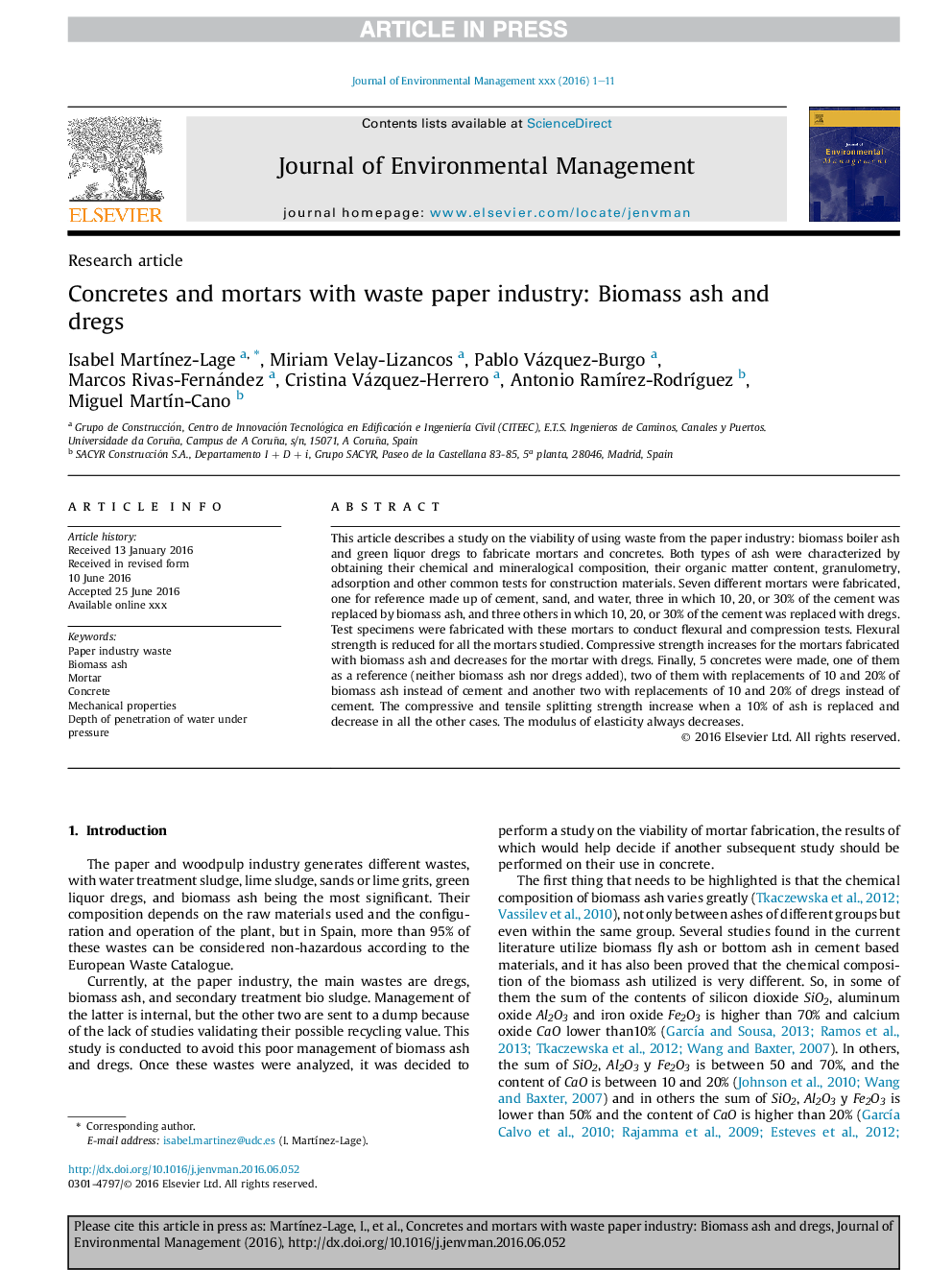| کد مقاله | کد نشریه | سال انتشار | مقاله انگلیسی | نسخه تمام متن |
|---|---|---|---|---|
| 7479925 | 1485231 | 2016 | 11 صفحه PDF | دانلود رایگان |
عنوان انگلیسی مقاله ISI
Concretes and mortars with waste paper industry: Biomass ash and dregs
ترجمه فارسی عنوان
بتن و ملات با صنعت کاغذ زباله: خاکستر و زهکشی های زیست توده
دانلود مقاله + سفارش ترجمه
دانلود مقاله ISI انگلیسی
رایگان برای ایرانیان
کلمات کلیدی
زباله صنعت کاغذ خاکستر زیست توده، ملات، بتن، ویژگی های مکانیکی، عمق نفوذ آب تحت فشار،
ترجمه چکیده
این مقاله یک مطالعه در مورد قابلیت استفاده از زباله از صنعت کاغذ را شرح می دهد: خاکستر دیگ بخار زیست توده و سبزی مشروب سبز برای ساخت ملات و بتن. هر دو نوع خاکستر با به دست آوردن ترکیب شیمیایی و کانی شناسی آنها، محتوای مواد آلی آنها، گرانولومتری، جذب و دیگر آزمون های معمول برای مصالح ساختمانی مشخص شد. هفت مخلوط مختلف ساخته شده است، یکی برای مرجع ساخته شده از سیمان، شن و آب، سه که در آن 10، 20 یا 30 درصد از سیمان با خاکستر زیست توده جایگزین شده و سه عدد دیگر که 10، 20 یا 30 درصد آن، از سیمان با ضایعات جایگزین شد. نمونه های آزمایشی با این ملات ساخته شده اند تا آزمایش های خمشی و فشرده سازی انجام دهند. استحکام خمشی برای تمام ملات مورد مطالعه کاهش می یابد. استحکام فشاری برای ملات ساخته شده با خاکستر زیست توده افزایش می یابد و برای ملات با قطرات آن کاهش می یابد. در نهایت، 5 بتن ساخته شد، یکی از آنها به عنوان مرجع (نه خاکستر زیست توده و نه ضایعات)، دو مورد از آنها با جایگزینی 10 و 20 درصد خاکستر زیست توده به جای سیمان و دو مورد دیگر با جایگزینی 10 و 20 درصد ضایعات به جای سیمان. قدرت تقسیم فشاری و کششی هنگامی که 10 درصد خاکستر جایگزین شده و در تمام موارد دیگر کاهش می یابد افزایش می یابد. مدول کشش همیشه کاهش می یابد.
موضوعات مرتبط
مهندسی و علوم پایه
مهندسی انرژی
انرژی های تجدید پذیر، توسعه پایدار و محیط زیست
چکیده انگلیسی
This article describes a study on the viability of using waste from the paper industry: biomass boiler ash and green liquor dregs to fabricate mortars and concretes. Both types of ash were characterized by obtaining their chemical and mineralogical composition, their organic matter content, granulometry, adsorption and other common tests for construction materials. Seven different mortars were fabricated, one for reference made up of cement, sand, and water, three in which 10, 20, or 30% of the cement was replaced by biomass ash, and three others in which 10, 20, or 30% of the cement was replaced with dregs. Test specimens were fabricated with these mortars to conduct flexural and compression tests. Flexural strength is reduced for all the mortars studied. Compressive strength increases for the mortars fabricated with biomass ash and decreases for the mortar with dregs. Finally, 5 concretes were made, one of them as a reference (neither biomass ash nor dregs added), two of them with replacements of 10 and 20% of biomass ash instead of cement and another two with replacements of 10 and 20% of dregs instead of cement. The compressive and tensile splitting strength increase when a 10% of ash is replaced and decrease in all the other cases. The modulus of elasticity always decreases.
ناشر
Database: Elsevier - ScienceDirect (ساینس دایرکت)
Journal: Journal of Environmental Management - Volume 181, 1 October 2016, Pages 863-873
Journal: Journal of Environmental Management - Volume 181, 1 October 2016, Pages 863-873
نویسندگان
Isabel MartÃnez-Lage, Miriam Velay-Lizancos, Pablo Vázquez-Burgo, Marcos Rivas-Fernández, Cristina Vázquez-Herrero, Antonio RamÃrez-RodrÃguez, Miguel MartÃn-Cano,
